It’s not just paint! Stain can have Lead too! Interior 1905 door: 987 ppm Lead (90 is unsafe for kids) + 157 ppm Arsenic!
Introduction (for those new to this website):
Tamara Rubin is a federal-award-winning independent advocate for consumer goods safety and a documentary filmmaker. She is also a mother of Lead-poisoned children, her sons were acutely Lead-poisoned in 2005. Since 2009 Tamara has been using XRF testing (a scientific method used by the U.S. Consumer Product Safety Commission) to test consumer goods for toxicants (specifically heavy metals), including Lead, Cadmium, Mercury, Antimony, and Arsenic. All test results reported on this website are science-based, accurate, and replicable. Items are tested multiple times, to confirm the test results for each component. Tamara’s work was featured in Consumer Reports Magazine in February of 2023.
 A Dark-stained original interior wood door
A Dark-stained original interior wood door
in a house built in 1905 (Portland, Oregon)
The door pictured above is in my home, which is in Portland, Oregon (USA), and was built in 1905. I believe (based on their design, construction, and test results) that these are the original doors from when the home was built. They were unpainted and instead have a dark stain on them. In the photo above, you can clearly see where a center cross board has had the surface removed (through the abuses by children over the years), exposing the natural wood color of the door. It is not uncommon for dark stain finishes like this to test positive for both Lead and Arsenic. I typically see wood stains of this era (in a range of colors/shades) testing positive for Lead at levels as high as 1,500 ppm (or higher) and for Arsenic at levels in the range of 150 to 300 ppm.
Can Arsenic levels like this have a human health impact?
Since Lead exposure is discussed everywhere on this blog, I wanted to take a moment to focus on the Arsenic concern here. I recently visited the home of a young boy who is “on the spectrum.” His mama’s doctor ordered a urine test. And, in addition to a Lead level that was literally “off the charts” at the highest reading available for the test done, his Mom unexpectedly tested positive for Arsenic. See her test results below.
In my experience working with families in the capacity of a Healthy Home Consultant, looking for sources of toxicant exposure in their personal possessions for more than a decade, I have seen that for hair or urine to test positive for Arsenic it nearly always correlates with a persistent exposure to some source of Arsenic in the home environment. This means something the person who tested positive uses or is exposed to in their daily lives. Below is the test result set for the mother in this family (shared with permission):
A walk-through of the family’s home revealed that the family (of means, with plenty of nice things — including many antiques) had an extensive collection of antique wooden furniture, including an antique piano, all with medium-to-dark stain finishes which were positive for Arsenic (most in the 200 to 300 ppm range). While I am not a doctor, and as such am not qualified to speculate about the specific health impacts on the family, the clear implication from the evidence of the urine test was that Arsenic was likely finding its way into the bodies of this family.
Old things create dust.
With the family mentioned above, the test results suggested that the large quantity of Arsenic-contaminated antiques in the home might likely be contributing to Arsenic exposure to both the mother and the child. The main suspected pathway for this is micro-dust created by the antique items simply sitting passively in the home. Antiques exude micro-dust over time even without use, and more so through movement and friction between surfaces (like cabinet doors, piano key covers, etc.). With this particular family — to help test my suspicion that the antiques in the home were creating Arsenic-laden micro-dust — we decided to also test the HEPA filter from the air purifier the family had sitting next to their piano. With high-precision XRF testing, the dust in the filter (a filter that had not been changed recently and therefore had a chance for dust to build up a bit) also tested positive for high levels of Arsenic, adding weight to the concern that the antique furniture might be creating an airborne dust hazard.
Why are there no scientific studies supporting your claims, Tamara?!
To my knowledge, there have not yet been any scientific studies to specifically evaluate the concerns for Arsenic in house dust created by the mere presence of antique furniture. That does not mean these are not legitimate observations about potential causal impacts (i.e. vintage or antique wood furniture contributing to a body burden of Arsenic in the inhabitants of a home) — it just means that no person or industry has seen a potential financial benefit of underwriting research into this sort of impact, and so studies along these lines have not yet been done. (Keyword: “yet.”)
It is also possible that I may simply be the first (or among the first) to draw these empirical conclusions — and this consideration has merely not yet been noted by the scientific research community as a concern, and as such, has just not yet been formally studied. Stay tuned, because often when I report about a new concern like this one the scientific community comes up with a research study that confirms my concerns/suspicions — usually about five to 10 years later.
What should I do about toxic metals in antique wood finishes?
In the meantime (prior to any formal studies being done to confirm this concern), please carefully consider the potential health impacts of any antique items you may have in your home and make your choices accordingly. If you collect antiques, perhaps consider asking your doctor for a hair or urine test — a comprehensive panel for heavy metals — so you can make informed decisions for your family.
I am also sometimes available for one-on-one home consultations depending on my travel schedule (you can read more about that here). I generally travel for this work in January, April, and October of each year. You can get on my schedule for an upcoming trip by confirming in advance — I usually have time to work with between two and four families at each location I travel to.
Paint-free does not mean Lead-free
Specific XRF test results for the door pictured above:
- Lead (Pb): 987 +/- 37 ppm
- Arsenic (As): 157 +/- 27 ppm
- Zinc (Zn): 37 +/- 12 ppm
- Iron (Fe): 241 +/- 41 ppm
- Titanium (Ti): 205 +/- 40 ppm
- Chlorine (Cl): 3,453 +/- 490 ppm
Lead Safe Mama’s solution: New doors/No friction
As with everything I write about, I try to find simple inexpensive solutions for families (including for my own family). Our solution to addressing the concern for Lead and Arsenic contaminated woodwork has been to replace or remove the offending components — OR at the least, to block them with furniture, lessening their use, and lessening the deterioration from movement, contact with, and impact from kids.
For us, this has meant removing several of the doors in our home (without replacing them) and also replacing several of our doors with brand-new unfinished/unpainted solid wood doors. Any new replacement doors have been installed with sufficient clearances ensuring there is no friction against the surrounding original frame (if we left the original door frame in place, as in the example pictured below). Otherwise, we install a new pre-hung door (i.e. complete with a new frame). In other cases, we have just removed doors entirely and disposed of them in our household trash, like the one in the room I am using as my home office! These are not final measures — as the remaining trim in the home can still create dust — but they were measures undertaken to lessen the impact while continuing to live in the home. Our goal is to replace all of the original trim and doors in our home in stages, as funding permits. You can see an example below of one of our replaced doors (with original trim).
Continue reading below the image:
As always, thank you for reading and for sharing my posts. Please let me know if you have any questions and I will do my best to answer them personally!
Tamara Rubin
#LeadSafeMama
Some additional images of these doors:
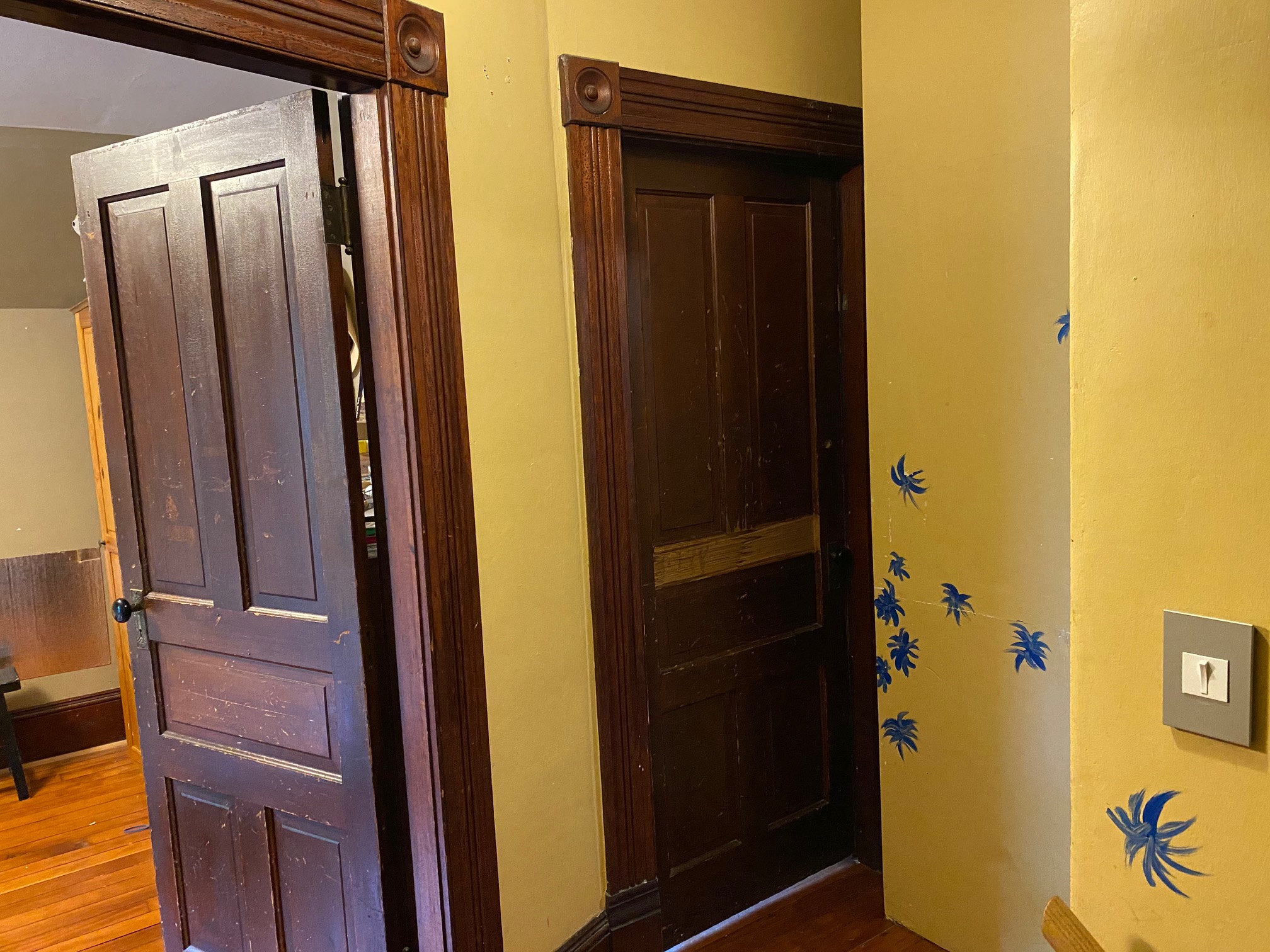
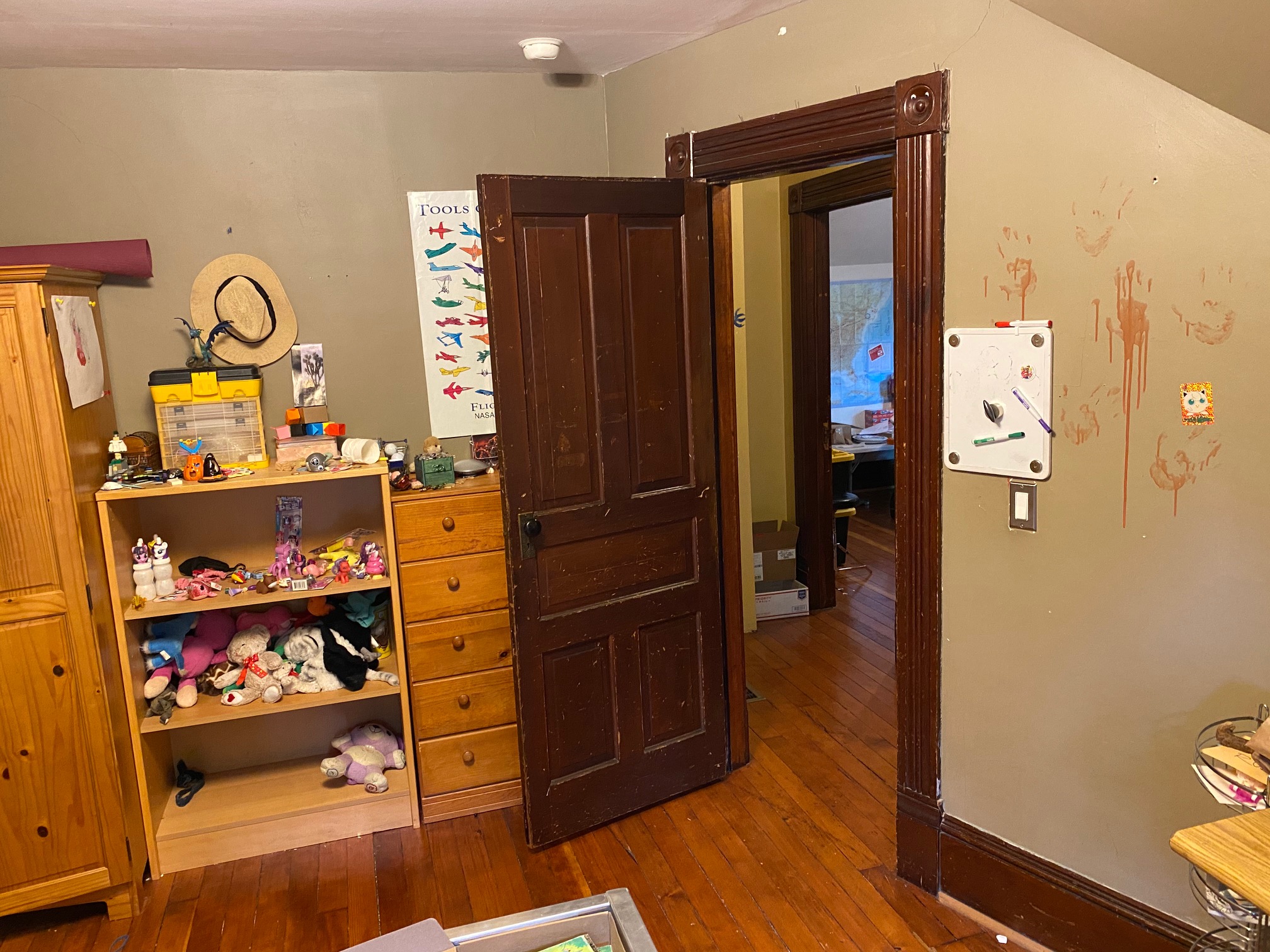
Never Miss an Important Article Again!
Join our Email List








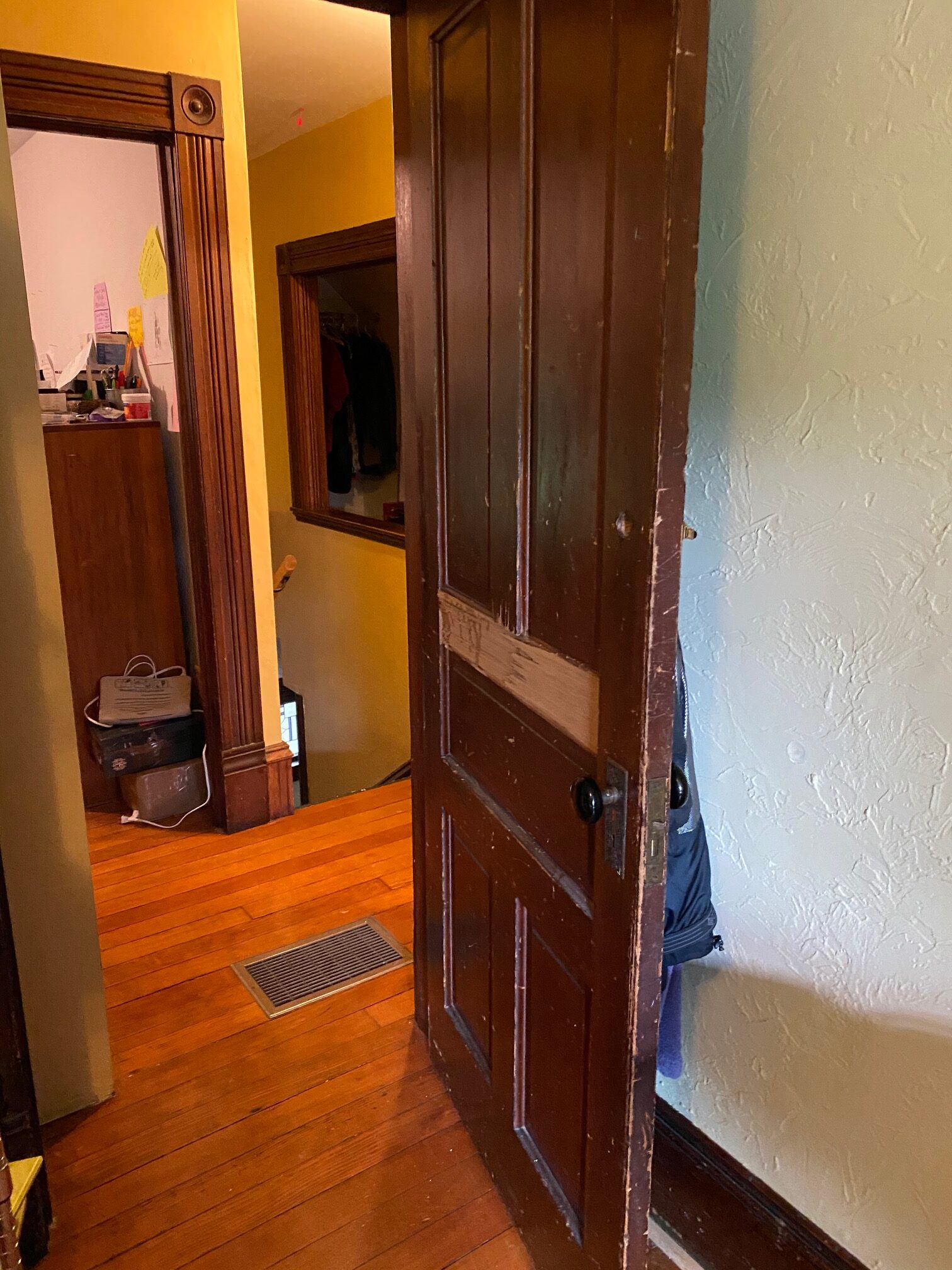
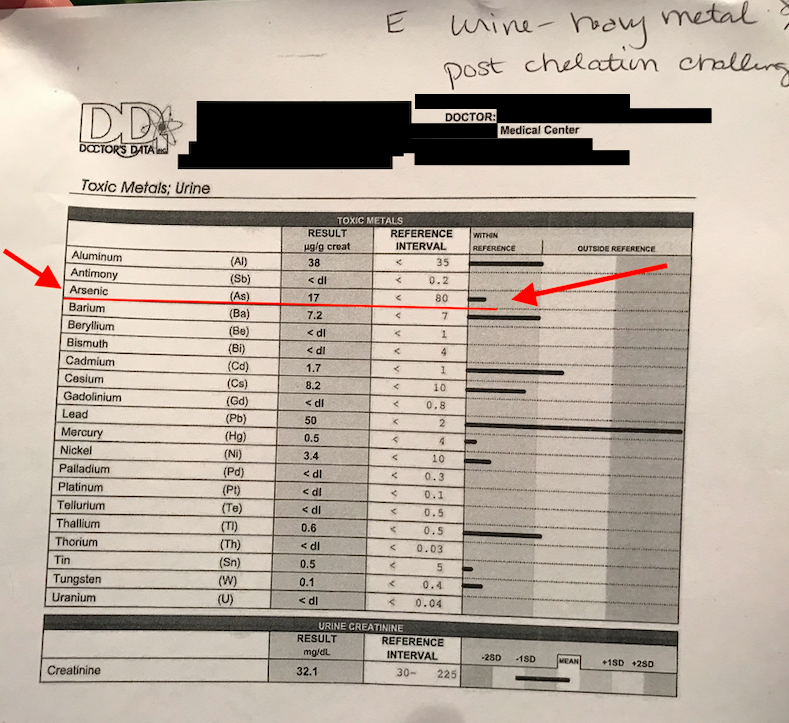
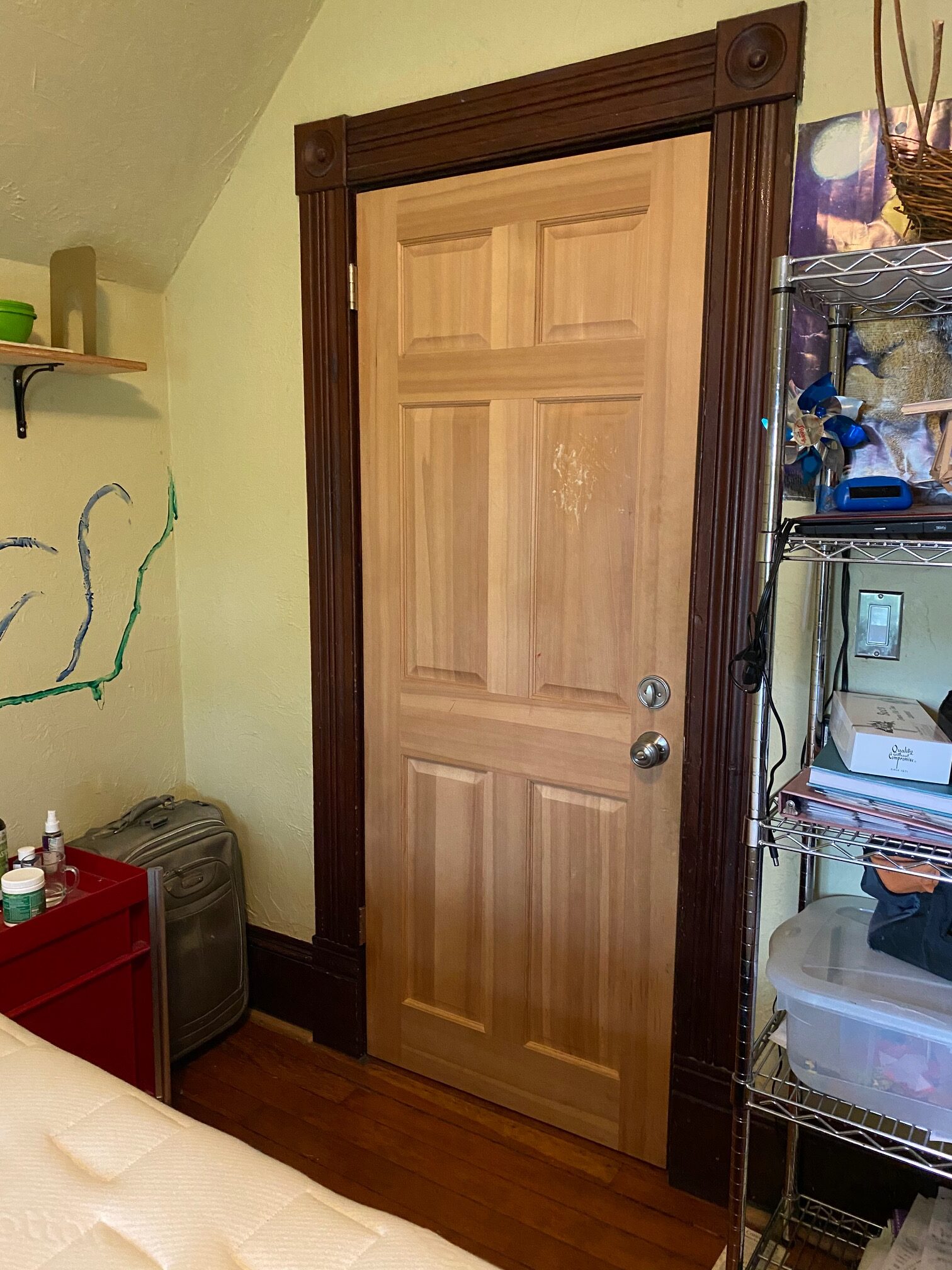
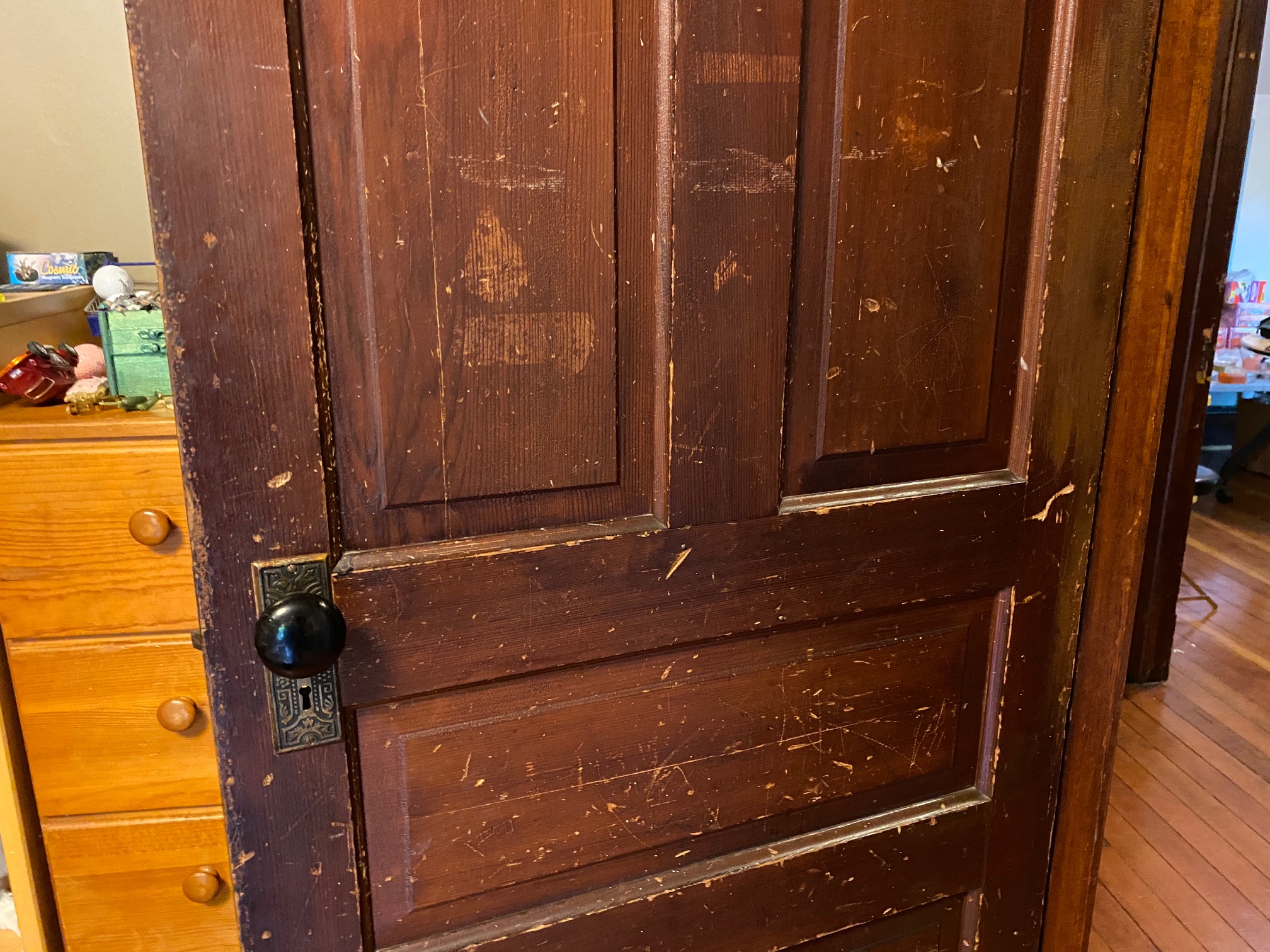

Hi there, on reading this interesting article from you about the antique doors and trim the question I have is—can’t they just be painted? Wouldn’t that contain the harmful stain underneath? I’m sure it’s best to remove and replace them but maybe paint as a temporary solution? Thanks for your all your work. Take care…
If there is lead present in the stain even though it is underneath new paint it still can create lead dust when the door is closed/ impacted in the jamb, door header area and if the new paint begins to chip on the door.
Lisa Seymour
Certified Lead Risk Assessor
Thank you for commenting Lisa!
– Tamara
What at-home lead test can be used to test furniture?
I have quite a bit of 1950s-1960s solid wood furniture in my house. It is all stained not painted. My trim is also all stained not painted (house was built in 1971) I have been sanding all the trim in my house not realizing varnish could contain lead. How concerned about the furniture should I be? Can varnish be tested with the lead swabs?
Did you end up testing your furniture? I’m looking to buy a 1960s coffee table (wood, no paint, not sure about the varnish) and not sure how likely it is to be leaded…
1960s might be fine – or could have low lead and trace arsenic. One way to address is to make sure put a new solid / stable / thick clear coat on before using. Earth paint out of North Carolina has a cashew based urethane that is a good choice (although I have not used it myself.)
T
I have some antiques in my home. If they are in tact with no chipping or peeling, is normal cleaning okay to keep them safe?
I would need more info to weigh in… what types of antiques? how old? what materials? Read this:
https://tamararubin.com/2020/05/i-heard-that-urine-and-hair-tests-for-heavy-metals-including-lead-were-not-real-or-useful-test-results-why-is-this/
Normal cleaning is generally not sufficient. The concern is microdust:
https://tamararubin.com/2019/03/the-sugar-packet-analogy-how-much-lead-dust-does-it-take-to-poison-a-child/
T
If the original doors are well hung to limit friction against the jamb, and are covered under latex paint, is the risk of lead dust fairly significantly reduced?
Can we move forward with the understanding that these doors and the floors beneath them should be regularly wet-wiped/wet-mopped?
Newborn in the house.
I am also struggling to understand how concerned I should be about the lead paint and stain in our home. I would also like to know your answer to Annie’s post above. I want to be safe without driving myself insane over it.
If it is over 90 ppm it’s a concern. I would get testing done to confirm the levels and whether or not it is a hazard. Dust wipe sample testing is best. Certified Kit sells dust wipe sample test kits: http://www.CertifiedKit.com Your local health department might offer testing for free. Get your kid tested in the meantime:
Read this: https://tamararubin.com/2019/02/blood-lead-testing-please-get-everyone-in-the-family-tested-since-you-have-been-living-in-a-house-with-high-lead-paint/
And Read this: https://tamararubin.com/2014/06/now_what/
You might also find my “Start Here” post helpful: https://tamararubin.com/2019/12/start-here/
Tamara
Thanks for this wonderful info of your experience with stains. Regarding clear varnish on older built-in furniture or elsewhere in homes, what’s been the range observed there? Similar to stains or higher ppm like older paints? Also, do you think a 3 M lead swab would have detected your home’s doors by turning pink at all? Or is that too low, around 1000 ppm, to change its color? I realize 3M states swabs can at times detect down to 600ppm, but are guaranteed to detect at 5000ppm and up, but wondering the reality and your experience with how low the swabs detect lead (by turning pink) in paint/varnish?
Thank you for this informative post. Have you tested much painted furniture from the 1940-1970 era, in particular the “French Provincial” style? It was painted an off-white to yellowish color with an accented line of gold-colored paint. It was a very popular bedroom style for girls. A quick online search will show many photos for reference. Thanks for branching out to the topic of furniture and home interiors. There’s so much to learn!
Is there an at-home test for arsenic on wood surfaces?
No – not that I am aware of.
T
Can’t you just sand it and refinish it?
Sanding is the quickest and simplest way to poison an entire home and everyone in it, unfortunately. Please watch my film.
I bought a solid quarter sawn oak table from the 1880’s and having it refinished. I don’t see how all antiques are poison . Please help me understand how my table could be dangerous. Thank you.
A lot of pieces from that era had stain with a mix of Lead and Arsenic as a preservative. It may be fine. Oak was also often left unfinished.
Hi!
Can stained wood be tested using the 3M swabs? Our home was built in 1958 and tested negative for lead, thank goodness, but has the original wood around the windows and as baseboards. All is stained but don’t know if original or not.
Hello! Just trying to strategize some risk mitigation strategies around this. For pieces that can be removed from the home, such as furniture or a door off the hinges, is there a reason that a stripped and refinished piece would pose a risk to the residents? (I realize there would be risk to the person completing the refinishing, but setting that aside). Secondly, would lead show up on a 3M test for wood finish? I have several pieces of 1950s furniture with a medium stain and am not sure how concerned to be. Lastly, has anyone ever heard of the Speed Heater? https://eco-strip.com/about/ . They claim their infrared heater only heats to 400-600℉ and that this is not hot enough to release fumes from lead. Does that sound possible or preposterous?
I have a home that was built in 1980. We have wood sub flooring right now in my kids play room that we found after we ripped out the previous carpet. We haven’t yet covered it. It’s wood that is stained dark. And we also have dark stained wood doors (unpainted) original to our house that we haven’t yet replaced in all our bedrooms. I never thought about lead being in wood stain… I’m freaked out. We are planning to replace soon but my kids have been exposed to it since we’ve lived here a year. How likely is it that these stains have lead if the home was built in 1980? Thank you!
It is really unlikely that a home from 1980 or later has Lead-contaminated stain.
T
My father has alot of antiques in the home, does this mean he should sell them? I have a 12 year old sister in the home
Hi,
Always love your work Tamara!!! Have spend lots of time on your site. Just got two questions for you:
1. My mother had had house built in 1913 and the entire inside of the house is very lightly clear stained. Is the clear stain less of a concern? Is it possible to seal again with new clear varnish to try to seal in the possible lead and arsenic?
Will be trying to get a free lead inspection soon
2. Have you seen the product fluro-spec and is it any good or not worth it($70)? as I think it only detects 500ppm or over. It’s a spray that after glow in presence of lead under UV light